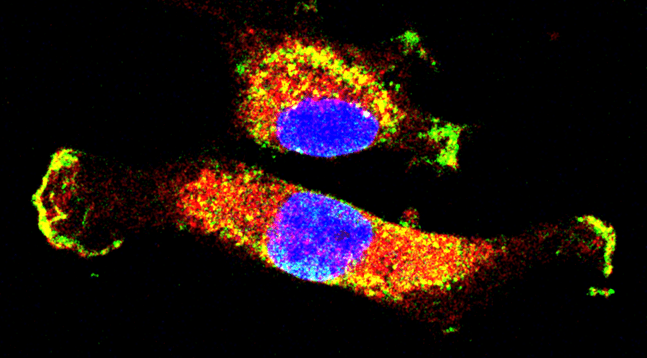Unravelling the circuitry that controls cancer growth and spread
Research led by Barts Cancer Institute (BCI), Queen Mary University of London, has revealed novel insights into the molecular circuitry controlling cancer cell growth and spread. The findings highlight new pathways involved in these key processes of cancer progression that may represent targets for therapies.
A complex communication network

The study, published today in Science Signaling, set out to uncover how a protein called MET drives cancer progression. Research has shown faulty or mutated versions of MET to be involved in cancer cell growth and spread in a variety of cancer types; however, the precise mechanisms by which it controls these processes are unknown.
MET belongs to a group of proteins called receptor tyrosine kinases (RTKs), which are key regulatory proteins involved in a variety of signalling pathways that control normal cellular processes. Abnormal changes to RTKs are implicated in the development and progression of many types of cancer, making them a popular target for cancer treatment.
The team, made up of researchers from the BCI, led by Dr Stéphanie Kermorgant, and The Institute of Cancer Research, London, including Dr Alexia Hervieu and Dr Paul Clarke, looked at cells and preclinical models in which MET was mutated. They found that the protein activated two distinct pathways to drive cancer cell growth and migration, by interacting with other key molecules that help MET to carry out these functions.
One molecule identified as a key player in these MET-driven processes was Rac1. It is widely understood that Rac1 is involved in cancer cell migration; however, the team found Rac1 to also be critical in driving cancer cell growth, via interaction with another protein called mTOR. This interaction occurs inside the cells (in structures called endosomes), followed by a relocation of the two molecules to the cell boundary - an unusual place for mTOR to be found. In a separate pathway, MET also communicates with another molecule, PI3K, to drive cell migration.

First author of the study Dr Hervieu, who did her PhD under Dr Kemorgant’s supervision and is currently a postdoctoral researcher at The Institute of Cancer Research (ICR), said:
“Grasping how MET controls cell behaviour in cancer is a crucial step towards improving treatment. The unexpected discovery of Rac1’s role in this context expands our understanding of how MET deregulates cells and opens new opportunities for cancer research.”
The research was primarily funded by Cancer Research UK and the Medical Research Council, with additional funding from the Rosetrees Trust, Breast Cancer Now and Pancreatic Cancer Research Fund.
Overcoming drug resistance
Cancer cell migration is key for metastasis - the spread of cancer cells from one site in the body to another. Metastatic disease is the leading cause of cancer mortality; however, there is currently no cure. Understanding the processes that drive metastasis and finding ways to stop these is vital for the development of more efficacious cancer treatments.
Drugs that target MET are being tested in clinical trials; however, patients often develop resistance to these drugs as the cancer can learn to activate the MET-driven pathways in other ways. The insights gained from this study may pave the way for the development of new treatment regimens; if drugs to target MET are used in combination with drugs that inhibit mTOR and PI3K, treatments may be effective for longer. Interestingly, drugs that inhibit mTOR and PI3K at the same time have recently been developed.
Dr Kermorgant said:
“We are very excited with this discovery which suggests that MET, a major cancer target, may be co-targeted with existing drugs against two other major targets, PI3K and mTOR. This could be tested in clinical trials in a near future.”
This study refines the current understanding of how MET controls the signalling pathways involved in cancer growth and spread, and identifies the key players involved in these processes. Targeting these molecules in combination may offer more efficacious treatment outcomes for patients with cancer.
Category: General News, Publications

No comments yet